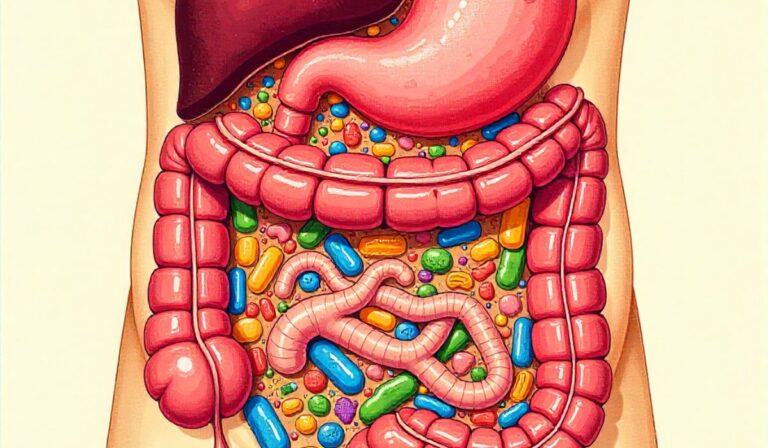Exercise Modality & Gut Health Resistance, Aerobic, HIIT Explained
Ever feel that your stomach is a little… off after a workout? Maybe you’ve noticed bloating or other digestive discomfort? You’re not alone!
The relationship between exercise modality and gut health is surprisingly complex. This post will break down how different types of exercise, like resistance training, aerobic activities, and high-intensity interval training (HIIT), can impact your gut.
You’ll learn which exercise styles might be best for a happy gut, helping you optimize your fitness routine for both physical and digestive well-being. Get ready to gain valuable insights to improve your wellness from the inside out!
Key Takeaways

Exploring the Gut-Exercise Connection
The connection between exercise and the gut is becoming increasingly clear. Our gut, or gastrointestinal tract, is home to trillions of microorganisms, collectively known as the gut microbiome.
This complex ecosystem plays a key role in our digestion, immune function, and even mental health. Regular physical activity can positively influence this intricate internal environment.
When we exercise, our bodies undergo various physiological changes that impact the gut, influencing everything from the types of bacteria that thrive to the overall health of our digestive system. Therefore, by understanding these connections, we can make informed choices that help us.
What is the Gut Microbiome?
The gut microbiome is the community of microorganisms living in your digestive tract. It includes bacteria, fungi, viruses, and other microbes.
Think of it as a bustling city inside your body. These microbes work together to help with digestion, especially breaking down foods that our bodies can’t digest on their own. They also produce vitamins, such as vitamin K and B vitamins.
The gut microbiome also plays a critical part in the immune system. It helps defend against harmful pathogens and keeps the immune system functioning properly. The balance of different types of microbes in the gut is vital for overall health.
An imbalance in the gut microbiome, sometimes called dysbiosis, can lead to various health problems, including digestive issues, weakened immunity, and even mental health challenges.
- Diversity of Microbes: The more diverse your gut microbiome, the healthier it generally is. A greater variety of microbes means a more resilient and adaptable ecosystem. This diversity helps in processing various types of food and defending against harmful pathogens.
A diverse microbiome supports a healthy immune system and overall well-being.
- Role in Digestion: Microbes break down complex carbohydrates and fibers that the human body can’t digest, extracting nutrients and energy. They convert food into usable substances, allowing your body to absorb the necessary vitamins and minerals.
Microbes are essential for efficient nutrient absorption and energy production.
- Impact on Immunity: The gut microbiome educates and trains the immune system to recognize and respond to threats. It helps to defend against infections and prevents the development of autoimmune diseases. The microbes strengthen the gut barrier, preventing harmful substances from entering the bloodstream.
A balanced microbiome helps to build a strong defense system.
- Production of Vitamins: Certain microbes synthesize essential vitamins like vitamin K and B vitamins. They provide critical compounds that your body needs for various functions, including blood clotting and energy metabolism.
The production of vitamins is critical for supporting metabolic functions.
How Exercise Affects the Gut Microbiome
Regular physical activity has a profound effect on the gut microbiome. Exercise can lead to an increase in the diversity and abundance of beneficial bacteria.
This shift can improve digestive function, enhance immune responses, and even reduce inflammation in the gut.
Engaging in different types of exercise, such as aerobic activities or strength training, can have different effects on the gut.
Understanding these differences allows you to customize your workout routine to support a healthy digestive system.
The changes that occur in the gut due to exercise may also impact metabolic health, including glucose control and weight management, which provides even more reasons to stay active.
- Increased Microbial Diversity: Exercise has been associated with greater diversity of gut microbes. This can lead to improved digestive health. A diverse microbiome is generally more resilient and better equipped to handle various challenges.
More types of microbes can lead to a healthier and more adaptable gut environment.
- Enhanced Production of Short-Chain Fatty Acids (SCFAs): SCFAs, such as butyrate, are produced by gut bacteria and are important for gut health. Exercise can promote their production, improving the health of the gut lining and reducing inflammation. SCFAs are a significant source of energy for the cells lining the colon.
Exercise can boost the production of compounds that support gut health.
- Reduced Inflammation: Regular physical activity has anti-inflammatory effects throughout the body, including the gut. Lower inflammation can reduce the risk of conditions such as inflammatory bowel disease (IBD). Exercise can modulate the immune response, leading to fewer inflammatory markers.
Exercise can reduce gut inflammation and improve overall digestive health.
- Improved Gut Barrier Function: Exercise may help strengthen the gut barrier, preventing “leaky gut.” A robust gut barrier prevents harmful substances from entering the bloodstream. By keeping the gut lining strong, exercise reduces the risk of systemic inflammation.
A stronger barrier supports a healthier gut environment.
Exercise Modality & Gut Health: Resistance Training
Resistance training, which involves lifting weights or using resistance bands, is another powerful form of exercise.
Besides building muscle and improving strength, it can also benefit your gut health. Resistance training, for example, may alter the gut microbiome in unique ways, affecting the types of bacteria present and how they function.
These changes can lead to improved digestion, reduced inflammation, and a stronger gut barrier. Understanding how resistance training affects the gut is key to optimizing your fitness routine for both physical strength and internal wellness.
How Resistance Training Affects the Gut
Resistance training can provide various benefits for gut health. For instance, changes in hormone levels during resistance training can influence gut functions.
Resistance training often causes an increase in anabolic hormones, which are hormones that support tissue growth and repair. These hormones can help to strengthen the gut lining and may also have positive effects on the gut microbiome.
By integrating resistance training into your routine, you can enjoy not only improved strength and muscle mass but also potential enhancements in your digestive health and overall well-being.
- Hormonal Influences: Resistance training can affect hormone levels, such as testosterone and growth hormone, which may positively influence gut health. These hormones contribute to tissue repair and can improve the strength of the gut lining. The interplay between hormones and the gut can help balance internal conditions.
Hormonal changes influence gut health.
- Improved Gut Barrier Function: Strengthening the gut barrier prevents substances from leaking into the bloodstream, reducing inflammation. Resistance training helps maintain the integrity of the gut lining, decreasing the risk of inflammatory bowel disease. A stronger gut barrier supports a healthy digestive environment.
A stronger gut lining protects the body.
- Reduced Inflammation: Resistance training can reduce systemic inflammation, including in the gut. This anti-inflammatory effect can alleviate symptoms of conditions such as IBS. By decreasing inflammation, the body is better able to heal.
Less inflammation can reduce digestive discomfort.
- Changes in Microbial Composition: The types of bacteria can shift after regular resistance training. Studies show that resistance training can increase the diversity and abundance of beneficial bacteria in the gut. These beneficial bacteria produce short-chain fatty acids, which promote gut health.
Beneficial bacteria is increased by this form of exercise.
Tips for Integrating Resistance Training and Gut Health
To integrate resistance training to improve gut health, you can follow a routine. You should start slowly and gradually increase the intensity and duration of your workouts.
It’s also important to pay attention to your diet, including a balanced diet rich in fiber, probiotics, and prebiotics. This combination of regular exercise and a gut-friendly diet can enhance your gut health.
By being consistent and mindful of your overall wellness, you can optimize your gut health while improving your physical strength.
- Start Slowly: If you are new to resistance training, begin with lighter weights and fewer sets to allow your body to adjust. Gradually increase the intensity and volume of your workouts. This approach will help you avoid injury and promote better digestive function.
Progress gradually to avoid overwhelming your body and gut.
- Focus on Proper Form: Ensure you use the correct form to prevent injuries and maximize the effectiveness of your workouts. Proper technique helps to engage the correct muscles and minimize strain on your digestive system. Consider consulting a trainer for guidance if needed.
Proper form prevents injuries and is key for effective exercise.
- Combine with a Gut-Friendly Diet: Eat a diet rich in fiber, probiotics, and prebiotics to support your gut microbiome. Fiber helps with digestion and keeps your gut bacteria happy. Probiotics introduce beneficial bacteria, while prebiotics feed the beneficial bacteria that you already have.
Eat for both your muscles and your gut.
- Stay Hydrated: Drink plenty of water before, during, and after your workouts to support digestion. Dehydration can negatively affect digestive function, making it important to stay hydrated. Water also aids in nutrient absorption and waste removal.
Staying hydrated can help with digestive function.
- Listen to Your Body: Pay attention to any digestive issues that arise during and after your workouts. Take breaks when needed and adjust your workout routine if necessary. Monitoring your body’s signals will help you adjust your routine for better health.
Pay attention to your body’s signals.
Exercise Modality & Gut Health: Aerobic Exercise
Aerobic exercise is any activity that raises your heart rate and increases your oxygen intake. Examples include running, swimming, cycling, and brisk walking. Aerobic exercise is renowned for its cardiovascular benefits, and it also plays a vital role in gut health.
These activities can lead to significant changes in the gut microbiome, leading to improved digestive function and overall well-being.
Incorporating regular aerobic exercise into your routine can boost your gut health and support a healthier lifestyle.
Aerobic Exercise and the Gut Microbiome
Regular aerobic exercise is very beneficial for the gut microbiome. These activities boost the diversity of the gut microbiome.
This diversity can lead to improved digestion and a stronger immune system. Aerobic exercise also reduces inflammation in the gut and enhances the production of beneficial short-chain fatty acids.
These effects improve the health of the gut lining and help with nutrient absorption. Understanding these connections can help you to choose a workout that will benefit you.
- Increased Microbial Diversity: Aerobic exercise can increase the variety of microbes in your gut. This increase supports a more resilient and balanced gut environment. The more diverse your microbiome, the better it can cope with changes and threats.
Increased diversity of microbes is a benefit.
- Enhanced Production of Short-Chain Fatty Acids (SCFAs): Aerobic exercise encourages the production of SCFAs, especially butyrate. Butyrate is a crucial nutrient for cells lining the colon. SCFAs also reduce inflammation.
More of these fatty acids improve your gut health.
- Reduced Inflammation: Aerobic exercise has anti-inflammatory effects that can reduce the risk of gut inflammation. Less inflammation supports a healthy digestive system, making you feel better. Anti-inflammatory effects support overall health.
This type of exercise is good for reducing gut inflammation.
- Improved Gut Motility: Aerobic exercise can improve the movement of food through your digestive system, reducing constipation. This regularity improves nutrient absorption and reduces digestive discomfort. Improved motility is a benefit for digestive health.
Improved motility aids digestion.
Practical Tips for Aerobic Exercise and Gut Health
Incorporating aerobic exercise into your routine can be easy. To maximize the benefits for your gut health, you can set achievable goals and gradually increase your exercise intensity.
It’s also important to combine aerobic exercise with a gut-friendly diet that is rich in fiber and probiotics. You can combine these aspects to boost your overall wellness.
This combination of exercise and a gut-conscious diet can enhance your digestive health and support a healthier lifestyle. This can become a lifelong healthy habit.
- Choose Activities You Enjoy: Select aerobic activities that you find fun, such as walking, running, swimming, or cycling. Choosing activities you enjoy makes it more likely that you will stick to your routine. When you enjoy your exercise, you are more likely to stay consistent and get long-term benefits.
Select activities you enjoy.
- Start Slowly and Progress Gradually: Begin with shorter sessions at a moderate intensity and gradually increase the duration and intensity of your workouts. This helps your body adjust to the increased activity. Doing so can reduce the risk of injury and support better digestive health.
Progress gradually to avoid overwhelming your body.
- Vary Your Workouts: Mix up your activities to keep things interesting and to target different muscle groups. Varying your exercise routine can help prevent boredom and engage your body in a variety of ways. Variety can also help to prevent overtraining.
Vary your exercise to keep it interesting.
- Pair with a Gut-Friendly Diet: Eat a diet rich in fiber, probiotics, and prebiotics to enhance the benefits of aerobic exercise for your gut. Fiber supports healthy digestion, probiotics add beneficial bacteria, and prebiotics help nourish those bacteria. Combining these practices provides comprehensive support for your digestive system.
Combine with a gut-friendly diet.
- Stay Hydrated: Drink plenty of water before, during, and after your workouts to support digestion and maintain optimal bodily functions. Hydration is also essential for maintaining the integrity of your gut lining. Proper hydration can help prevent digestive discomfort and help nutrients absorb.
Stay hydrated to boost digestion.
Exercise Modality & Gut Health: HIIT Workouts
High-intensity interval training (HIIT) involves short bursts of intense exercise followed by brief recovery periods.
It’s known for its efficiency in burning calories and improving cardiovascular fitness. HIIT workouts also have unique effects on gut health.
By exploring the advantages of this exercise method, you can learn how it can improve your digestive health and overall wellness.
Understanding how HIIT affects your gut allows you to make informed choices that support a healthy gut.
The Impact of HIIT on the Gut
HIIT workouts offer an opportunity to improve gut health. HIIT has the potential to shift the balance of bacteria in your gut, promoting greater diversity and the presence of beneficial microbes.
HIIT exercises can lead to a reduction in inflammation and enhance the production of crucial short-chain fatty acids.
These effects contribute to a healthier gut lining and may improve digestive function. By including HIIT in your workout regimen, you can experience both fitness gains and the potential benefits for your digestive health.
- Increased Microbial Diversity: HIIT can increase the variety of microbes in the gut. This can result in a more balanced and robust gut environment. Greater diversity can improve the gut’s ability to adapt to different challenges.
More variety in microbes can benefit you.
-
- Enhanced Production of SCFAs: HIIT has been linked to increased production of SCFAs, such as butyrate, which nourish the gut lining. SCFAs also have anti-inflammatory effects, which can benefit overall gut health. Boosting SCFAs can improve digestion and reduce inflammation.
More of these compounds are beneficial.
- Reduced Inflammation: HIIT can reduce inflammation in the gut, improving symptoms associated with digestive conditions like IBS. Lower inflammation can create a healthier digestive environment. By lowering inflammation, the body can heal and function better.
This exercise form is good for reducing gut inflammation.
- Potential for Improved Gut Barrier Function: HIIT may improve the gut barrier, making it less “leaky.” This is important for keeping the gut lining healthy and reducing the risk of inflammation. A strong gut barrier prevents harmful substances from entering the bloodstream.
A stronger barrier can help protect you.
Best Practices for HIIT and Gut Health
To make the most of HIIT for your gut health, you can incorporate it into your routine. You should also pay attention to your diet and lifestyle choices.
Always listen to your body and adjust your workouts. Prioritizing hydration and fueling your body appropriately are also critical.
By following these practices, you can use HIIT to enhance your physical fitness while promoting a healthy gut and overall well-being.
- Start with a Warm-Up: Prepare your body with a warm-up before each HIIT session. This helps to prevent injuries and prepares your muscles for the intense exercise that is coming. Warming up will help with your performance and make you feel good.
Preparing your body is key.
- Choose Activities You Enjoy: HIIT can be adapted to many forms of exercise, so choose activities you find interesting, such as running, cycling, or bodyweight exercises. Finding activities you enjoy will make it easier to maintain a regular HIIT routine. This will help ensure you stay consistent with your workout.
Choose activities you enjoy to make the workout easier.
- Balance Intensity and Rest: Alternate between short bursts of high-intensity exercise and brief rest periods. This combination is what defines HIIT and offers benefits for fitness and gut health. Proper balance supports your fitness journey and reduces risks.
Balance intensity and rest to get results.
- Pair with a Balanced Diet: Combine HIIT with a diet rich in fiber, probiotics, and prebiotics to maximize benefits for your gut. A balanced diet provides essential nutrients, and specific foods can help your gut. Together, these strategies can boost digestive health and overall wellness.
Eat the right diet to get the benefits.
- Listen to Your Body: Pay attention to how your body feels during and after your workouts. Adjust the intensity, duration, or frequency of your workouts if you experience digestive discomfort. Listening to your body can prevent injuries and help maintain a sustainable fitness routine.
Listen to your body to avoid any problems.
Comparing Exercise Modalities: Resistance, Aerobic, and HIIT
Resistance, aerobic, and HIIT workouts can each positively impact gut health, but they affect the body in slightly different ways.
Resistance training builds muscle mass and improves strength. Aerobic exercise boosts cardiovascular health, and HIIT offers an efficient way to improve both cardiovascular fitness and muscle tone.
Understanding the unique advantages of each modality allows you to create a workout routine that fits your individual needs and goals.
You can balance your routine, mixing these types of exercise. These can combine to boost overall fitness and enhance your gut health.
Here’s a comparison of the potential effects of each exercise modality on the gut:
| Exercise Modality | Primary Benefits | Gut-Specific Effects | Considerations |
|---|---|---|---|
| Resistance Training | Muscle strength, bone density, and metabolism. | May increase beneficial bacteria and improve gut barrier function. | Focus on proper form, listen to your body, and consume adequate protein. |
| Aerobic Exercise | Cardiovascular fitness, endurance, and weight management. | Boosts microbial diversity, enhances production of SCFAs, and reduces inflammation. | Choose activities you enjoy, progress gradually, and combine with a gut-friendly diet. |
| HIIT | Efficient calorie burning, cardiovascular fitness, and muscle conditioning. | May increase microbial diversity, boost SCFAs, and reduce gut inflammation. | Start with a warm-up, alternate intensity with rest, and listen to your body. |
Which Exercise Is Best for Your Gut?
The “best” exercise for gut health depends on your individual needs. All three modalities can benefit your gut, but the choice comes down to personal preference, fitness level, and specific health goals.
To optimize your gut health, you can start by trying different types of exercise. Finding the type of exercise that you enjoy can help improve both your physical and digestive health.
- Consider Your Fitness Goals: If your goal is to build muscle, resistance training should be a priority. For cardiovascular health, aerobic exercise is essential. For efficiency, HIIT is the best choice. Think about your goals when you choose an exercise.
Think about your goals when choosing an exercise.
- Assess Your Fitness Level: Start with exercises that match your current fitness level. If you are new to exercise, begin with low-impact activities like walking. Gradually increase the intensity and duration as your fitness improves.
Start with exercises that you are comfortable with.
-
- Listen to Your Body: Pay attention to how your body feels during and after exercise. If you notice digestive discomfort, adjust the type, intensity, or duration of your workouts. Adjust as needed to feel your best.
Pay attention to your body and make adjustments.
- Combine Different Modalities: Incorporating a mix of resistance training, aerobic exercise, and HIIT into your routine can provide the most comprehensive benefits. Combining different types of exercises can keep you engaged and benefit both your gut health and overall fitness.
Combine different types of exercise for the best results.
-
- Consult with Professionals: If you have any underlying health conditions or concerns about gut health, talk to your doctor or a certified fitness professional. They can help you create a safe and effective exercise plan. Talking to these professionals can provide personalized advice and ensure your safety.
Seek professional advice for the best approach.
FAQ Of Exercise Modality & Gut Health Resistance, Aerobic, HIIT Explained
What type of exercise is best for someone with IBS?
A: Both aerobic exercise and resistance training have been shown to help reduce symptoms of IBS, but the ideal choice varies per individual. Some people find that low-impact activities such as walking or swimming are the most beneficial. It is best to try different methods.
Can exercise help reduce gut inflammation?
A: Yes, regular exercise can help reduce systemic inflammation, including in the gut. Both aerobic exercise and HIIT have been proven to have anti-inflammatory effects that support gut health.
How long do I need to exercise to see an improvement in my gut health?
A: Results can vary, but many people see improvements in their gut health within a few weeks of beginning a consistent exercise routine. Consistent practice can lead to positive changes over time. The benefits will increase as you practice consistently.
Does the timing of my workouts matter for gut health?
A: Yes, the timing of your workouts can impact gut health. Exercising at consistent times each day can help regulate your circadian rhythm, which in turn can support healthy gut function. However, it is the overall routine that matters most.
How does diet affect the results of exercise on gut health?
A: Diet is extremely important. Eating a diet rich in fiber, probiotics, and prebiotics can enhance the benefits of exercise for gut health. A balanced diet supports the gut microbiome, working together with exercise to optimize results. Your results will be better.
Final Thoughts
The impact of exercise modality and gut health is clear: whether you choose resistance training, aerobic activities, or HIIT, you are likely to see positive benefits.
All types of exercise have the potential to improve your gut microbiome. You can experience reduced inflammation, and enhanced digestion.
Remember to listen to your body. You should start gradually and focus on activities that you enjoy. You should also pair your workouts with a gut-friendly diet.
By making the right choices and finding the right approach, you can optimize your fitness routine for a healthier gut and a more vibrant life. Prioritize your gut health to maximize your results!


![The Dangers of At Home Microbiome Tests A Closer Look[1]](https://mycleanseplan.com/wp-content/uploads/2025/11/The_Dangers_of_At-Home_Microbiome_Tests__A_Closer_Look1-768x448.jpg)
![Engineered Synbiotics Gut Intervention for Health Enhancement[1]](https://mycleanseplan.com/wp-content/uploads/2025/10/Engineered_Synbiotics__Gut_Intervention_for_Health_Enhancement1-768x448.jpg)
![Decoding the Gut AI and LLMs' Role in Microbiome Research[1]](https://mycleanseplan.com/wp-content/uploads/2025/10/Decoding_the_Gut__AI_and_LLMs_Role_in_Microbiome_Research1-768x448.jpg)

![Gut Dysbiosis in Irritable Bowel Syndrome (IBS) A New Approach[1]](https://mycleanseplan.com/wp-content/uploads/2025/10/Gut_Dysbiosis_in_Irritable_Bowel_Syndrome_IBS__A_New_Approach1-768x448.jpg)